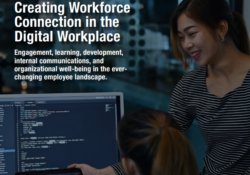Welcome to the Spring Issue of Workforce Solutions Review. And what better welcome to Spring/Summer than doing something new by leading with The Back Story by Katherine Jones.
Regular readers are used to opening from the back to read the latest and greatest by Katherine, but given all the changes we are heralding, it seemed fitting to start with an article that continues to be prescient on what is going on in the business world. It was particularly noteworthy to me that 47% of job switchers miss their old job, and 62% feel that the job they quit was better than what they are doing today. These were significant findings cited in “Where, Oh Where, Have My Skilled Employees Gone” on those who made a transition, but there are still two out of every five workers still looking to make a change. Confused? Don’t be. Workforce planning and Workforce Analytics provide the promise of helping figure out how to make it all fit for your workforce and keep the right people exactly where you need them.
Next up in this issue is “Are You Prepared for Your HR Technology Deployment and Adoption Journey?” This collaborative effort by Erica Arnold and Brian Buck from The Hackett Group addresses steps to ensure the success of your HR technology deployment efforts, and who better than authors from an organization that continues to be at the forefront of researching and identifying key success factors to ensure that the next technology solution isn’t a lift-and-shift with the same issues vs. a change initiative that addresses fundamental requirements of your organization. The foundational work required before implementing an HR technology to mitigate risk and increase the likelihood that goals you have established will be attained is an effort with great rewards.
Mick Collins facilitates an interactive discussion with three experts from Corporate HR and IT in “The Evolution of the Corporate IT vs. HR Technology Relationship.” Who better to opine on what really happens from both an HR and IT perspective than practitioners who have been living this change for years? Do not miss the insights from Steve Secora, Sean Junor, and Dave Curtis with a perspective only practitioners can offer. Mick does a great job conducting a great three-way discussion and then wrapping it up into a cohesive perspective from people at the front line in this evolving partnership.
Why do we need human capital metrics and reporting in company disclosures? It seems obvious that understanding the impact on human capital has never been more challenging than it has been in the past few years. Challenges with visibility, communication clarity and understanding the real needs of the workforce have never been tougher, so the mandate for “Human Capital Reporting “to Be or Not to Be” seems more pressing than ever. The call for effective, immediate, and compelling solutions has never been more pressing. Dennis Higgins and Lee Webster illustrate that without human capital metric standards, everyone is flying blind, not just investors but employees, insurers, investors, policymakers, and even corporate executives who seek benchmarks to compare themselves.
In this issue, we were fortunate to have two articles from Visier, a company recognized for leadership in people analytics with 15,000 customers in 75 countries. Demonstrated clearly in these two articles is that Visier has a team of people who not only know what they are talking about but are passionate about sharing insights and suggestions that can make a difference.
Savi Chakraborty, Lexy Martin, Kevin MacDuff and Victoria Nordal write the first article. Together they discuss how and why leaders need to work closely with Human Resources to take a proactive approach to address performance in the hybrid workplace and plan their future workforce accordingly. Planning your workforce to ensure that employees are performing at the expected level, staying happy at work, not burning out, and finding meaning in their roles can play a crucial role in preventing your business from having retention issues. Their article, “Planning for Optimal Performance in the Post-Pandemic World,” illustrates that when employees feel fulfilled, find meaning in what they are doing and love coming to work, their teams are better, faster, and stronger. Exciting stuff!
In “Why Do Managers Hire Externally Even When It’s Against Their Best Interest?” Dr. Amy Smith, Dr. Andrea Dearler, Kater Cheek and Mike Everitt show the data that nearly a third of employees who left their organization during the pandemic are making over 30% more, which means hiring externally may cost an organization up to 30% more than what the previous role paid. Even if your company knows that its headcount requirements necessitate external hiring, establishing a pipeline and having a growth mentality will serve your organization in the future. This article presents three intriguing data points that illustrate how investing in staff will have a payoff. Establishing a pattern of hiring internally can build a positive circle of skills development. By hiring inter-departmentally, you build teammates with a broader range of skills. This has multiple benefits for both the employee and the company. Broader skill sets provide the kind of agility companies need to adjust to a tumultuous business environment.
Increasing the integration and visibility of other IHRIM activities through the platform of Workforce Solutions Review is an ongoing priority and “Placing Small Bets: How Workforce Planners – and IHRIM – Balance Action and Adaptability” initiates a forum that we want to revisit regularly with updates on future direction and activities for IHRIM. By grouping common business and HR strategies together, workforce planners can focus interventions on reducing talent risks while retaining the flexibility to pivot should other scenarios prove more likely to be realized. To improve our member and community segmentation, IHRIM is committed to improving how we solicit, capture, and apply feedback on our programs. This article illustrates how running tests or small bets can have positive results, even if the hypothesis is not supported – organizations may build institutional knowledge, acquire a deeper understanding of customer needs, or eliminate blind spots that hinder future projects. IHRIM Chair Mick Collins shares some of the small bets IHRIM has made as we look to the future – committing to action and investments but retaining the need for flexibility. Make it a point to catch up today and in the future on some of these small bets for IHRIM.
“An Interview with Jacqueline Kuhn” by Renee Shapiro provides insight about Ms. Kuhn, an HR professional with over 25 years of experience in strategic planning, systems management, project management, services delivery and general human resources. Throughout Jacqueline’s career, she has worked with organizations in all sectors global and domestic to create strategic plans around their human capital management systems, as well as leading selection and implementation projects for talent management, talent acquisition and HRIS systems. Jacqueline spends much of her time with HCM vendors being briefed on their technology offerings, ensuring that the most current information is available to clients looking for a new solution.
Changing culture is never easy, but after reading “May the Force Be With You: Using Mental Models to Change Company Culture,” you will have a solid roadmap to make it happen. Starting by first understanding what culture is and then taking concrete steps without a clear understanding of what it is, is impossible. Culture must be built, and Derek Cabrera and Dr. Laura Cabrera suggest focusing on a process for incrementally building support for the culture change you seek—rather than attempting an organization-wide change at the start. In other words, start by asking yourself who is on board with the organization’s key mental models and who is not (and to what degree). Their article also highlights a powerful tool for organizational change.
The final article in this quarter’s WSR is an article called, “AI, Panacea or Peril” written by me. Given the flurry of recent developments in artificial intelligence, the imperative for us to consider potential implications and set future deployment strategy is increasingly urgent. The reality that futuristic cinematic portrayals are tomorrow’s reality should merit additional apprehension for us all.
Finally, we want to thank you again for being a loyal follower of Workforce Solutions Review. The IHRIM leadership team has collectively reviewed the ongoing delivery of the Workforce Solutions Review and has decided that this will be the final print publication. While many of us enjoy receiving and reading a physical publication, we realized we may be better served to put our time and effort into building a digital platform where we have the flexibility to add both volume (number and length of articles) and frequency (updating WSR content monthly).
With this news, our intent is to release new content monthly via this website while still providing you the option to print a PDF version of the overall issue. By releasing content monthly, our goal is to continue to provide the most current and relevant content to our IHRIM Members and additional subscribers.
We are excited about what this means for IHRIM and WSR as we move forward. We have plans for adding additional topics, IHRIM information and expanded scholarly content in the form of blogs, webinar summaries and other featured content. Our format may be changing in the months ahead, but our goal is to increase the frequency and the quality of our interaction with you our reading audience.
We look forward to what is next!


